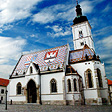KUMROVEC – TITO’S
BIRTHHOUSE MUSEUM
Staro Sela – Old Village of Croatian Heritage
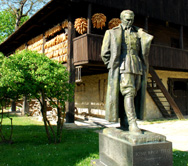 He
was often referred to as “strongman” Marshal Tito. Jozip
Broz Tito managed to hold together seven separate ethnic regions
into the unified country of Yugoslavia. From 1943 on he served as the
supreme
commander of the Yugoslav army with the rank of Marshal of Yugoslavia.
He came to prominence as the leader of the resistance against the Germans
in WWII and from 1953 to his death in 1980, was President of the Socialist
Federal Republic of Yugoslavia. In the west, during the cold war years,
he was thought of as the “good” communist, merely a socialist,
for his stand of non-alignment against the Soviets and his less restrictive
form of socialism. His funeral was attended by a who’s who of western
leaders, but like all “strongmen” held a tight reign on
individual countries hoping for independence by a powerful secret police,
a network of informants, intimidation and assassins who would target
expatriate dissidents.
He
was often referred to as “strongman” Marshal Tito. Jozip
Broz Tito managed to hold together seven separate ethnic regions
into the unified country of Yugoslavia. From 1943 on he served as the
supreme
commander of the Yugoslav army with the rank of Marshal of Yugoslavia.
He came to prominence as the leader of the resistance against the Germans
in WWII and from 1953 to his death in 1980, was President of the Socialist
Federal Republic of Yugoslavia. In the west, during the cold war years,
he was thought of as the “good” communist, merely a socialist,
for his stand of non-alignment against the Soviets and his less restrictive
form of socialism. His funeral was attended by a who’s who of western
leaders, but like all “strongmen” held a tight reign on
individual countries hoping for independence by a powerful secret police,
a network of informants, intimidation and assassins who would target
expatriate dissidents. 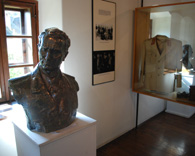 Jozip
Tito was born in 1892 in the village of Kumrovec in Krapina-Zagorje,
Croatia on the Sutla River which forms the natural border between the
modern Republics of Croatia and Slovenia. His father was Croat and his
mother Slovenian, which perhaps led him to the concept idea of unified
regions. At the time of his birth in the 1890s Kumrovec was in a combined
feudal region of Croatia-Slavonia under the contol of the Austro-Hungarian
Empire.
Jozip
Tito was born in 1892 in the village of Kumrovec in Krapina-Zagorje,
Croatia on the Sutla River which forms the natural border between the
modern Republics of Croatia and Slovenia. His father was Croat and his
mother Slovenian, which perhaps led him to the concept idea of unified
regions. At the time of his birth in the 1890s Kumrovec was in a combined
feudal region of Croatia-Slavonia under the contol of the Austro-Hungarian
Empire. The Old Village Museum - Staro Sela of Kumrovec
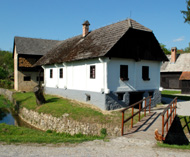 Today
the village surrounding the house where Tito was born is an open air “Ethnographic
Museum” representing
life as it was at the turn of the last century. Twenty preserved and
reconstructed houses of thatched roofs along with another several dark
black wood barns hung with traditional
Today
the village surrounding the house where Tito was born is an open air “Ethnographic
Museum” representing
life as it was at the turn of the last century. Twenty preserved and
reconstructed houses of thatched roofs along with another several dark
black wood barns hung with traditional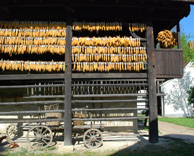 drying
corn stalks make up the open air museum. Ambling through the
old world village set in a quiet
park will reveal representations of the life styles of Zagorian families
of the time, and the work of blacksmiths, potters, yarn and toy-making.
The Old Village is mostly inhabited by the still and silent mannequins
of the exhibits and lively chickens wandering about from the present
day farm next door, almost indistiguishable from the museum buildings
except for
the tractor
in
front.
drying
corn stalks make up the open air museum. Ambling through the
old world village set in a quiet
park will reveal representations of the life styles of Zagorian families
of the time, and the work of blacksmiths, potters, yarn and toy-making.
The Old Village is mostly inhabited by the still and silent mannequins
of the exhibits and lively chickens wandering about from the present
day farm next door, almost indistiguishable from the museum buildings
except for
the tractor
in
front.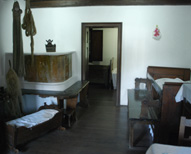 The
house where Tito was born, built in 1860 and the first brick house constructed
in the area, was made a museum in 1952, standing much as
it was when his family lived there, holding photographs, documents, uniforms
and artifacts of Marshal Tito’s personal history. A bronze statue
of Tito by Croatian artist Antun Augustincic, stands outside, strong
and powerful “father” of his country, ever on vigil, thoughtful
and pensive - circa 1943 before he gained a few pounds. Tito is buried
in Belgrade, Serbia, once the capital of Yugoslavia. Of the Croatians
and
others who
desired
a
separate
national
identity Tito said “The River Sava will run backward before there
is an independent Croatia…
The
house where Tito was born, built in 1860 and the first brick house constructed
in the area, was made a museum in 1952, standing much as
it was when his family lived there, holding photographs, documents, uniforms
and artifacts of Marshal Tito’s personal history. A bronze statue
of Tito by Croatian artist Antun Augustincic, stands outside, strong
and powerful “father” of his country, ever on vigil, thoughtful
and pensive - circa 1943 before he gained a few pounds. Tito is buried
in Belgrade, Serbia, once the capital of Yugoslavia. Of the Croatians
and
others who
desired
a
separate
national
identity Tito said “The River Sava will run backward before there
is an independent Croatia… 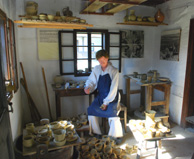 We
have spilt an ocean of blood for brotherhood and unity of our peoples…” It
took another wave of blood after he was gone for the countries which
formed
the former Yugoslavia to become indepentent states. For some, Jozip Broz "Marshal" Tito
is surely a national hero who saved his countrymen from Nazi and Soviet
domination, his birthplace a shrine, for others maybe a past best left
as a museum. He is certainly a huge historic figure and the open air
cultural museum which grew around his birthplace through the 1970s
and 80s is a very unique and special spot to visit in the green
hills of the north Croatian countryside.
We
have spilt an ocean of blood for brotherhood and unity of our peoples…” It
took another wave of blood after he was gone for the countries which
formed
the former Yugoslavia to become indepentent states. For some, Jozip Broz "Marshal" Tito
is surely a national hero who saved his countrymen from Nazi and Soviet
domination, his birthplace a shrine, for others maybe a past best left
as a museum. He is certainly a huge historic figure and the open air
cultural museum which grew around his birthplace through the 1970s
and 80s is a very unique and special spot to visit in the green
hills of the north Croatian countryside.The village museum has a snack shop to get an ice cream and a souvenir shop where one can pick up a Tito memento, a framed photo or a keychain. A short distance away in a bend of the Sutla River is a stone obelisk monument erected in 1935 to honor the Croatian National Anthem, celebrated as a local holiday. Kumrovek in Krapina-Zagorje is a little under an hour from Zagreb by car. A Baroque manor house of the noble Erdody family is 2 kilometers in the village of Razvor. © Bargain Travel Europe
Find best hotel and travel deals in Croatia on TripAdvisor
These articles are copyrighted and the sole property of Bargain Travel Europe and WLPV, LLC. and may not be copied or reprinted without permission.
SEE ALSO:
CASTLE HOTEL DVORAC GJALSKI - KRAPINA-ZAGORJETRAKOSCAN CROATIA'S ROMANTIC CASTLE
ZRINSKI CASTLE MUSEUM - MEDIMURJE CAKOVEC
VARAZDIN - CROATIA'S LITTLE VIENNA
STARA KAPELA ETHNO-VILLAGE - SLAVONIA

